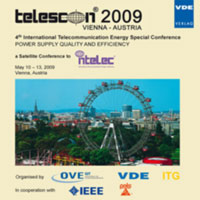Increasing Grid Transmission Capacity and Power Quality by new Solar Inverter Concept and Inbuilt Data Communication
Konferenz: telescon(R) 2009 - Power Supply Quality and Efficiency - 4th International Telecommunication - Energy special conference
10.05.2009 - 13.05.2009 in Vienna, Austria
Tagungsband: telescon(R) 2009 - Power Supply Quality and Efficiency
Seiten: 5Sprache: EnglischTyp: PDF
Persönliche VDE-Mitglieder erhalten auf diesen Artikel 10% Rabatt
Autoren:
Grass, Norbert (Ohm-University Nuremberg, Institute of Power Electronic Systems, Germany)
Witzmann, Rolf (Technische Universität München, Institute of Power Transmission Systems)
Sebeck, Markus (iAd GmbH, Grosshabersdorf, Germany)
Keck, Reinhold (Siemens AG, Fürth, Germany)
Inhalt:
Increasing regenerative power sources installed in low voltage grids tend to cause overvoltage problems due to the reverse power flow direction. Consequently, regenerative sources need to be turned off temporarily or on the long term, the grid infrastrucutre would have to be extended by the utility company. Additionally, the increasing number of grid connected power electronic systems causes a high level of reactive power flow and harmonics in the grid affecting power quality. The concept described in this paper uses reactive power which is generated in the solar power inverters to increase power capability of the grid. By means of additional reactive power consumption, the grid voltage can be decreased to acceptable values and stabilized. Grid extension in many cases can be avoided or, at least it can be delayed. For control of a distributed system of a number of solar inverters installed in a grid segment distributed data collection and central control is required. Data and control parameters are being transmitted over the power lines with inbuilt real time DLC (distribution line carrier) communication. Additionally, the inverters can be remotely controlled to compensate harmonic distortion and to improve phase voltage balance by feeding unsymmetrical currents into the three phases. The concept can be applied not to solar power systems only; it is rather a basic technology which can be used in future grids with distributed generation and storage. Even the power consumption in the grid can be optimized accordingly to the generation if remotely controllable appliances will be installed in the future. With the technology shown in the paper higher reliability, increased and controllable power quality and less problems in low voltage grids can be achieved. Thus, the capability to accept, integrate and transmit higher quantities of decentralised generated power can be improved.


